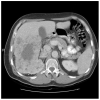Advanced-stage renal cell carcinoma treated by radical nephrectomy and adjacent organ or structure resection
- PMID: 18782305
- PMCID: PMC2769168
- DOI: 10.1111/j.1464-410X.2008.08025.x
Advanced-stage renal cell carcinoma treated by radical nephrectomy and adjacent organ or structure resection
Abstract
Objective: To examine the effect of radical nephrectomy (RN) with adjacent organ and structure resection on survival, as invasion of adjacent organs in patients with renal cell carcinoma (RCC) is rare.
Patients and methods: After institutional review board approval, we reviewed our database and statistically analysed of patients with pathological stage T3 or T4 RCC who had RN and resection of a contiguous organ or structure.
Results: We identified 38 patients of 2464 (1.5%) who had RN with adjacent organ or structure resection. The median (interquartile range) size of the mass was 11 (8-14) cm, and the follow-up 13 (5-33) months. Most patients (68%) were pT4 stage and had conventional clear cell carcinoma (95%). Fourteen patients (37%) had positive surgical margins. The liver (10) was the most commonly resected adjacent organ or structure. Only one patient remains alive with no evidence of disease at 5 years, while three are currently alive with disease. Overall, 34 of 38 patients (90%) ultimately died from disease at a median (range) of 11.7 (5.4-29.2) months after surgical resection. The surgical margin status was the only statistically significant factor for recurrence and death (P = 0.006).
Conclusions: The prognosis for patients with advanced RCC and adjacent organ or structure involvement is extremely poor and similar to that of patients with metastatic disease. These patients should be thoroughly counselled about the impact of surgical management and considered for entry into neoadjuvant or adjuvant clinical trials with new targeted systemic agents.
Figures



Similar articles
-
Renal cell carcinoma clinically involving adjacent organs: experience with aggressive surgical management.Cancer. 2007 May 15;109(10):2025-30. doi: 10.1002/cncr.22629. Cancer. 2007. PMID: 17420980
-
Positive surgical margin following radical nephrectomy is an independent predictor of local recurrence and disease-specific survival.World J Surg Oncol. 2017 Nov 2;15(1):193. doi: 10.1186/s12957-017-1257-6. World J Surg Oncol. 2017. PMID: 29096642 Free PMC article.
-
The natural history of renal cell carcinoma with isolated lymph node metastases following surgical resection from 2006 to 2013.Urol Oncol. 2019 Dec;37(12):932-940. doi: 10.1016/j.urolonc.2019.08.003. Epub 2019 Sep 27. Urol Oncol. 2019. PMID: 31570248
-
Nephron-sparing surgery for renal cell carcinoma: clinicopathologic features predictive of patient outcome.Urology. 2003 Oct;62(4):641-6. doi: 10.1016/s0090-4295(03)00489-8. Urology. 2003. PMID: 14550434 Review.
-
Long-term survival of patients with unilateral sporadic multifocal renal cell carcinoma according to histologic subtype compared with patients with solitary tumors after radical nephrectomy.Urology. 2004 Sep;64(3):462-7. doi: 10.1016/j.urology.2004.04.016. Urology. 2004. PMID: 15351571 Review.
Cited by
-
Large cell non-Hodgkin's lymphoma masquerading as renal carcinoma with inferior vena cava thrombosis: a case report.J Med Case Rep. 2011 Jun 28;5:245. doi: 10.1186/1752-1947-5-245. J Med Case Rep. 2011. PMID: 21711523 Free PMC article.
-
Robot assisted "en bloc" radical nephrectomy, splenectomy and distal pancreatectomy for renal cell carcinoma: case report and illustration of technique.J Robot Surg. 2016 Dec;10(4):375-378. doi: 10.1007/s11701-016-0614-8. Epub 2016 Jul 22. J Robot Surg. 2016. PMID: 27450465
-
Renal Cell Carcinoma with or without Tumor Thrombus Invading the Liver, Pancreas and Duodenum.Cancers (Basel). 2021 Apr 3;13(7):1695. doi: 10.3390/cancers13071695. Cancers (Basel). 2021. PMID: 33916652 Free PMC article.
-
WHO/ISUP classification, grading and pathological staging of renal cell carcinoma: standards and controversies.World J Urol. 2018 Dec;36(12):1913-1926. doi: 10.1007/s00345-018-2447-8. Epub 2018 Aug 19. World J Urol. 2018. PMID: 30123932 Free PMC article. Review.
-
Management of colon-invading renal cell carcinoma: Operative technique and systematic review.Urol Ann. 2021 Jan-Mar;13(1):1-8. doi: 10.4103/UA.UA_86_20. Epub 2021 Jan 19. Urol Ann. 2021. PMID: 33897156 Free PMC article. Review.
References
-
- Jemal A, Siegel R, Ward E, et al. Cancer statistics. Vol. 58. a cancer journal for clinicians; CA: Mar-Apr, 2008. pp. 71–96. 2008. - PubMed
-
- Tamaskar I, Garcia JA, Elson P, et al. Antitumor effects of sunitinib or sorafenib in patients with metastatic renal cell carcinoma who received prior antiangiogenic therapy. The Journal of urology. 2008 Jan;179:81–6. discussion 6. - PubMed
-
- Motzer RJ, Michaelson MD, Rosenberg J, et al. Sunitinib efficacy against advanced renal cell carcinoma. The Journal of urology. 2007 Nov;178:1883–7. - PubMed
-
- Flanigan RC, Mickisch G, Sylvester R, Tangen C, Van Poppel H, Crawford ED. Cytoreductive nephrectomy in patients with metastatic renal cancer: a combined analysis. The Journal of urology. 2004 Mar;171:1071–6. - PubMed
Publication types
MeSH terms
Grants and funding
LinkOut - more resources
Full Text Sources
Medical

